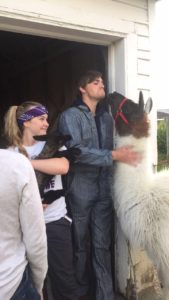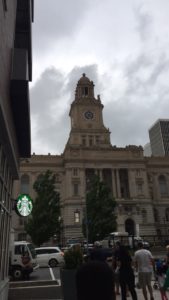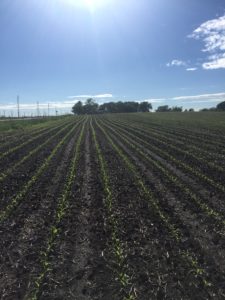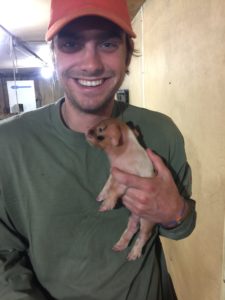Since our 1995 Grand Marquis was still at the car whisperer’s, our day on Friday, May 19 began a little earlier than normal. We had to be outside the Sweeney’s and waiting for H-N at 6:30 to make it to the Stole house with enough time to eat breakfast. Once we arrived, Diane’s quiche and banana bunt cake were there waiting. After our breakfast and daily brief, we quickly loaded into the van. We were forced to make the thirty-minute drive to Ames, to meet with Liz Kolbe of Practical Farmers of Iowa, in heavy rain.
When we arrived at Practical Farmers of Iowa, we were greeted by the office dog, Ginger. After we played with Ginger for a few minutes, Liz welcomed us and showed us to our meeting room. While the coffee was brewing, we began our discussion about the organization and some of the issues it handles. Unlike Iowa Corn, PFI does not address many policy issues; it does NOT have a lobbying arm. It does on occasion make recommendations to the Farmers Union regarding policy issues that it might consider for its agenda. They work with farmers
They are simply there for outreach and to let farmers know there is a helpful group on their side. One of the main issues we discussed was pesticide drift. In order to become and remain an organic farmer, you can’t use certain pesticides. However, if the farmer next to you isn’t organic and sprays his fields, there is a large chance that it could drift onto yours. If this happens, you can lose your organic certification. To combat this, Practical Farmers of Iowa produces literature, in cooperation with the Pesticide Bureau, of what to do if this happens to you. After our pesticide talk wrapped up, Sophie even got to hear what it is like to join their starter farmer program.
After we left Liz’s office, we had the opportunity to drive around the campus of Iowa State University. Although it was a nasty day, the campus was still amazing. Growing up about twenty minutes outside the University of South Carolina, I figured all big state schools would look the same; spread out, huge dorms, a lot of cheap apartments, and integrated within the city. However, this wasn’t true for Iowa State and Ames. The campus was massive, but also very compact within its realm. It seems like everyone I’ve met on this trip went to Iowa State, so it was cool to see the place. Once we left campus, we drove back to Morris’s for a break.
After our short break, which mostly consisted of eating homemade granola bars, we were off to “It’s All Good,” owned by the Fiscus family, for some lunch and ice cream. Once we finished our quick meal, we were off to Des Moines Water Works again. However, instead of touring and meeting will Bill Stowe like the day before, we met with Josh, an environmental lawyer at the Environmental Law and Policy Center. With the help of Jen, Josh discussed the case that DMWW was involved in. He explained how it went through the judicial system and how the impact of the case could have impacted the environment in a positive way. However, due to political pressures, a lot of parties that could have helped DMWW stayed out of it. At the end of his talk, Josh explained how he progressed to being an environmental lawyer and he began working at the ELPC. He even touched on his current bid for Des Moines City Council.
Once we left Des Moines, we headed back to Ames to go to Wheatsfield Cooperative. When we arrived at Wheatsfield, we were greeted with goodie bags that consisted of some literature, pins, and chocolate. After a short intro by Kim, we took a tour of the cooperative. She briefly touched on where their foods come from and how they choose their vendors. Kevin, the cheese maker we met with on Thursday, is even a featured producer there. After our tour, we ate a dinner consisting of some house-made favorites and local milk. Once we finished eating, we made our way back to the Stole house. Our night then consisted of talking and enjoying our free time.
|
\







